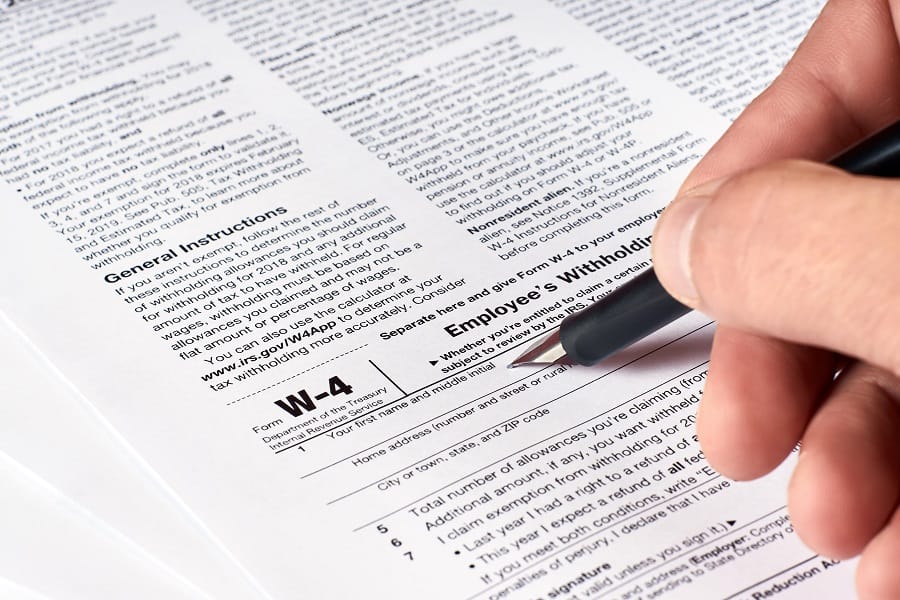How Does Payroll Withholding Help a Company’s Employees?
Written by: Natalie Fell
Natalie is a writer with experience in operations, HR, and training & development within the software, healthcare, and financial services sectors.
Reviewed by: Daniel Eisner
Daniel Eisner is a payroll specialist with over a decade of practical experience in senior accounting positions.
Updated on September 12, 2023

Paying taxes is a necessary duty, and payroll taxes are no exception. Employers are responsible for making sure a portion of employee wages are withheld each pay period and allocated to federal, state, and local governments.
Payroll withholding not only fulfills a legal obligation, but it can also help your employees. This guide explains the ins and outs of payroll withholding, as well as its advantages.
What Is Payroll Withholding?
Payroll withholding refers to the process of setting aside a portion of an employee’s wages to pay taxes. Each employee’s withholding total is unique and depends on their circumstances and household. The primary beneficiary of these taxes is the federal government, but wages are also commonly withheld to pay state and local taxes. Some of the most common withholdings are related to federal and state income taxes and unemployment taxes.
When it comes to paying your employees, taxable wages are withheld from gross pay, or the total they are owed for their work each pay period. The amount left over after all withholdings and deductions are accounted for is known as their net pay, which is what they receive in their paycheck. Net pay is also known as “take-home pay”.
When an employer withholds and pays the applicable taxes for their employees, it’s one less thing employees need to worry about when filing personal tax returns. Without employer withholdings, each employee would be responsible for setting aside the right amount of wages to pay their own taxes. If there are any errors in their calculations or they fail to save enough money throughout the year, they could face a surprisingly large payment when taxes are due.
In addition to making your employees’ lives easier, the government also benefits from tax withholdings originating from the employer. Employers are required by law to make regular tax payments on behalf of their employees, streamlining the process and resulting in more reliability and consistency.

Form W-4
Because each employee’s withholdings are unique, it’s important for employers to know how much of their wages to set aside to fulfill their tax obligations. Luckily, the government-required W-4 form contains all of the information an employer needs. A new employee should complete a W-4 form as part of their new hire paperwork.
A W-4 form details an employee’s filing status, which relates to their marital status and family situation. It also collects how many jobs an employee has as well as their allowances, or number of dependents. You can download the latest version of Form W-4 from the Internal Revenue Service website.
Withholding Requirements for Employers
Employers are required to withhold wages for several different types of taxes. Let’s take a closer look at these requirements.
Income Tax
The United States federal government requires each citizen to pay income tax. Each individual state may have its own specific income tax requirements as well. To determine how much you should withhold from your employees’ federal income taxes, you’ll use the information provided on their W-4 as well as the current federal income tax rate.
Each state with an income tax requirement typically requires employers in that state to have employees complete a state-specific income tax form. These forms are usually found on the state’s Secretary of State or Department of Revenue website. It’s important for employers to stay on top of any rate changes or new laws to ensure their withholdings are correct.
FICA
FICA (Federal Insurance Contributions Act) taxes are actually two separate taxes under one withholding. The government sponsored Social Security and Medicare programs are funded through FICA taxes. Both employers and employees contribute to FICA, and employers are required to withhold their employees’ portion. The current FICA tax rate for employees is 7.65%, 6.2% of which is allocated to Social Security and 1.45% toward Medicare.
Additional Withholdings
In addition to withholdings required by the government, employers often withhold a portion of employee wages to go towards company-sponsored benefits. An example of this would be a company’s health insurance plan, which is usually funded by both the employer and the employees. Withholding an employee’s contribution directly from their wages ensures their portion of the insurance is always paid and keeps them in good standing.
If employers offer a 401(k) plan to help employees save for retirement, wages will also be withheld and deposited into an employee’s account on their behalf. However, these deductions are made pre-tax, as the employee will ultimately be responsible for the income taxes on these funds when they eventually withdraw them.
Another withholding an employer may be responsible for is a garnishment. Garnishments are debts ordered by a court of law that are to be paid off directly from an employee’s wages. In addition to withholding the correct amount, employers handle the payment of garnished wages directly to the court. Some common situations that result in garnishments are alimony, child support, unpaid taxes, and defaulted loans.
Payroll Withholding Tips
Making sure withholdings are correct for each employee is no small task, especially for employers with a large number of employees on their payroll. However, there are ways to streamline the process and increase efficiency.
One of the best ways to make payroll processing more seamless is to set up a separate payroll bank account. Handling payroll with your regular business bank account is usually not a good idea. It makes it harder to track withholdings and separate your payroll transactions from the rest of your business banking. Keeping your payroll finances in their own unique account makes it easier for you to ensure you have enough wages withheld to pay taxes.
Another way to avoid the hassle of withholding is to outsource your payroll processing to a service provider. Hiring an experienced payroll service provider allows you to focus on other key business functions and also provides peace of mind that your payroll taxes are paid and accounted for. If you don’t have the funding or capacity to outsource payroll, you should at least consider investing in payroll accounting software to help you track withheld wages and ensure accurate bookkeeping.
Summary
As an employer, making sure you withhold and file payroll taxes is a must. And it’s critical that it’s done right: incorrect calculations or late payments could result in costly fines and penalties.
Enlisting the help of a payroll service provider or using advanced payroll software can make your life a whole lot easier. When your employee withholdings are properly accounted for, it’s a win-win for your workforce, the government, and your business.
